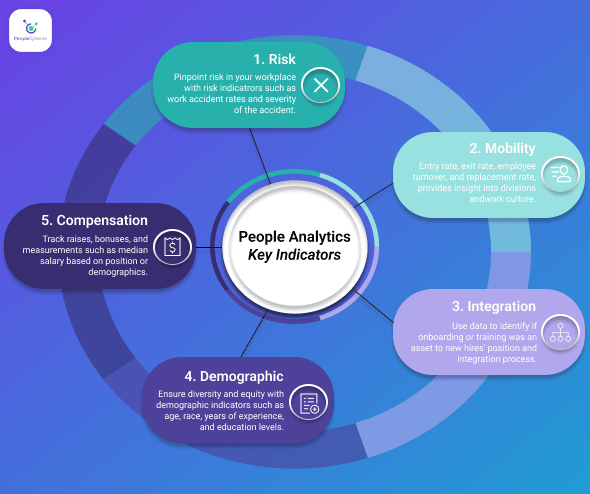-666x380.jpg)
As companies begin to realize the importance of collecting data, specifically people data, it is necessary to be able to interpret what the information means for your organization and its talented employees who are concentrated on increasing competencies.
Your company’s human resource department should collect data on HR key metrics, such as absenteeism, retention rates, and more, to optimize HR management. Strategic human resource management can make or break your organization’s performance, so learning to understand your employee trends can drastically change your workforce and work culture for the better and improve your talent management overall.
Related articles:
Which KPIs to Optimize for HR management?
What is HR Analytics? 5 Ways it Can Boost Your HR Performance and Productivity
What is People Analytics?
People analytics is a part of the process to collect, track, and create reports with key metrics about a company’s work culture and employees. People analytics is usually collected and formed through Human Resource Information Systems (HRIS). Coupled with powerful HR reporting tools, an HR system can help centralize all of your data in a singular location while allowing HR professionals to view real-time data in seconds.
People analytics boosts HR performance and productivity. It can be used to improve multiple categories within your HR management, such as:
1. Employee experience
2. Insights about your workforce
3. Prioritazition of HR initiatives
4. Decision-making
5. Talent management and recruiting
6. And much more…
HR Predictive Analytics
Leveraging AI‑powered HR analytics further enhances predictive accuracy, enabling HR teams to anticipate workforce trends and proactively support employee success. People analytics can also be used to make predictive analysis. Predictive analytics offers HR professionals to forecast and predict different outcomes from actions and decisions within the company. There are many ways to use HR predictive analytics, and your imagination is your only limitation. Some examples to use are: boost employee retention rates, improve diversity and equality, and upgrade recruitment process.
Predictive analytics gives you a competitive advantage in the market by allowing you to recruit top talent, increase employee satisfaction, and retain valuable employees.
Employee Feedback
Regular feedback takes your people analytics to the next level. Most commonly, employee feedback refers to the process where managers guide employees by providing them constructive feedback in terms of suggestions and opinions.
Employee feedback is an essential cornerstone in employee experience. It makes your employees feel heard and valued, you gain more ideas to choose from, you eliminate conflicts before they occur and become an issue in your workplace, and your employee performance and engagement improve. Employee feedback can occur in different shapes, such as:
1. New employee surveys
2. Employee engagement surveys
3. One-to-one interview
4. Reviews and review site
6. Stay interviews
Why is People Analytics Important?
People analytics is imperative to the success of your organization, especially when it comes to your workforce. Through collecting and reporting data, you will be able to identify trends about your employees and their experience at your company. These reports can also assist in forming business decisions and lead to a higher quality work environment.
People analytics is essential to ensure that you have efficient and optimized HR processes, such as talent management. Since the success of a business often depends on the talent of its employees, measuring the business impact of your talent management is crucial. People analytics assures an objective perception of the strengths, challenges, and potential of your workforce and a clear way of measuring and analyzing it.
For example, if you found that your marketing department had a much higher turnover rate than others, your HR director could take action in that department to boost retainment rates and address other issues before finding your marketing team overworked and understaffed. Reporting people analytics can help human resource personnel discover potential problems before they become expensive, time-consuming to solve, and sabotages your human resources functions.
Best HR Reporting Tools for People Analytics
There are different ways on how to use HR analytics tools for people analytics. Some of them include:
1. Workforce analytics
2. Forecasting employee turnover
3. Talent management analytics
4. Actionable insight
5. Reporting
When searching for the best HR reporting tools for people analytics, it is important that you already have in place an HR tech stack that can collect, centralize, and report real-time data. Reporting tools can then be used to query your data and consolidate all metrics in one centralized location. Along with those key factors, your HR reporting tool should create customizable dashboards using employee data from multiple data sources. This will also help with the surge of remote workers and their experience dealing with technology advancements the company want to integrate. In a study conducted in 2020, they compared how employees and employers differed in opinion concerning remote working. The findings showed that:
74% of employees believed that their organization would be more successful with remote working.
Mercer
This was confronted with management being afraid of how remote working might change the industry. While both parties have a point, this problem can easily be solved with the implementation of an HR system that can help with the accessibility of employers having a better connection with their employees in this transition and the employee being able to facilitate the incorporation of remote working.
PeopleSpheres is an HR platform that allows you to centralize your data from all your existing systems that you use to collect employee data and improve the human capital management through this step. By having all your data in one data hub, you can create dashboards, allow HR departments to create thorough reports effortlessly and help with the organization of finding each HR metric to increase employee satisfaction.
What Metrics to Report?
When determining what key indicators for people analytics you would like your HR system to collect and measure, it is important to keep in mind what your company goals are. Do you want to focus on retainment rates? Do you want to see how effective your new training module was? Well, a centralized data hub gives business leaders the ability to answer these questions and give you the opportunity to automate all your systems into one information-system.
Some of the most crucial metrics to keep an eye on are risk, mobility, integration, demographics, and compensation indicators:
1. Risk Indicators
If your employees engage in physical labor or potentially dangerous tasks, it is extremely important to keep track of accidents. Along with following labor laws and caring for your employees, HR reporting could pinpoint recurring accidents or how to lower risks on the job.
There are many risk indicators your organization can keep track of, but here are a few: work accident rates and severity of the accident. In addition to pinpointing risks, HR reports and metrics can indicate if there is a disconnect in training or management.
Through recording risk indicators, your company can work on administering better management practices, increasing employee performance with fewer accidents, and providing a better employee assistance.
As an employer, keeping your employees safe is the most important thing you can do. Work culture and trust are imperative to the advancement of your company. Jeopardizing the well-being of an employee, especially if the accident was preventable, sends a poor message to your current employees, potential new recruits, and customers. Make sure to realize what is most valuable at your organization, your loyal employees that serve your customers or clients.
2. Mobility Indicators
Employees may come and go for many reasons, such as moving cities, medical leave, or retirement. For this reason, tracking metrics on mobility indicators is essential for your organization. Mobility indicators, such as entry rate, exit rate, employee turnover, and replacement rate, can provide significant insight into the different divisions and the work culture at your organization.
Human resource managers can gather mobility data through exit interviews with employees who are branching off from your company. HR information systems can then use this data to oversee all areas of the company, create reports to identify potential problems and create better labor-relations.
Identifying the problem that is causing a dramatic shift in mobility factors, such as turnover rates, can increase productivity, retention, and profit when your HR department takes action in addressing these concerns. If your organization can prevent upticks in turnover and replacement rates, your company’s reputation and employee experience can improve drastically.
3. Integration Indicators
Allowing new employees to feel at home can make a huge difference in the new hire experience. Employees want to feel valued in their office, no matter if they are an intern or a senior consultant. When deciding what indicators to measure, do not skip out on integration indicators, such as an extension of internship and arrivals/departures.
Integration after recruitment, training, and onboarding can change the trajectory of employee performance and experience at your organization. For interns, evaluate their performance and track if they have been offered an extension for the future. Communicate and assist new team members to help acclimate them to their new workplace. Use data and HR reports to identify if onboarding or training was an asset to their new position and integration process.
4. Demographic Indicators
There are many demographic indicators your company can track, such as age, race, years of experience, and education levels. This is important data to have when trying to ensure diversity and equity among your workforce. In addition to DEI efforts, your HR director can get a headcount of who could potentially be retiring soon through tracking age, or who might be looking for a higher position due to their years of experience or education level.
HR reports and demographic data can reveal numerous things about your employees, but they can also show a lot about your company, as a whole. Your departments should have diversity on every single level to help make better-informed decisions that align with your business needs. It is important to have different age ranges, education levels, years of experience, and races on each team since every member will bring a plethora of knowledge from their individual work and life experiences.
The creation of an inclusive work environment can boost performance, creativity, and the employee experience at your workplace. The perks of tracking demographic indicators are perfectly summed up by Claudia Brind-Woody when she said, “I’ve always said: smart teams will do amazing things, but truly diverse teams will do impossible things”.
5. Compensation Indicators
As salary transparency continues to boom across LinkedIn and other social media networks, tracking compensation indicators has become even more important. Compensation is one of the biggest expenses your organization will incur, so it is imperative to manage the payroll and ensure it is going to the right places. Compensation indicators should track many different metrics, such as median salary, payroll, and overtime. To create a strong work culture, payroll should be fair and based on position, experience, and education. HR personnel should track raises, bonuses, and other payroll increases to monitor them on HR reports. The HR reports can prevent salary inequalities and other potential payroll issues.
HR compensation reports can also find your organization’s median salary based on different positions. These metrics will give your company a competitive edge in salary. You can adjust your salary levels to compete against other local organizations to recruit top talent.
Compensation indicators can be tracked based on many different demographics, like age, education level, and race. Compensation metrics should be used to recruit new talent, retain current employees, and manage salary inequalities. Use data and compensation to your advantage!

Conclusion
People analytics should not be overlooked when dealing with recruitment of new hires, retain loyal employees, and create a strong workforce in your organization. These five indicators, risk, mobility, integration, demographics, and compensation can reveal patterns and trends about what is happening inside of your company within your workforce management.
As an organization with valuable employees, the best thing you can do is ensure their safety, well-being, experience during the workweek and how you manage the learning and development of each employee. In a study conducted in 2021, researchers compared their findings to the previous year and found that:
There was a decrease in how employees saw their career and advancement to previous years, with only 52% of employees feeling that there was support for their career advancement and development.
McLean & Company
It is important to create equal opportunity and fair compensation for all employees through demographic and compensation indicators but preventing severe accidents through the use of risk indicators should be a priority across every organization.
Once you determine what indicators for people analytics your HR department will track, make sure you put all of the data in one centralized data hub to make reporting and analytics easier. By providing an integrated HR platform and data hub, all your HR technology will be into one main management software and help with the organization of all your HR systems. PeopleSpheres is designed to change the way you use people data and identify employee trends.
Data can drive many business decisions and employee experience should be one of them to improve the performance management for employees. Your organization’s employees will definitely notice human resources management ensuring a diverse, fair, and safe work environment through using people data and HR reporting. This will simplify all the processes for the HR manager as it will simplify data and will guide the organization into being more actionable through data-driven information. This should cover data on employee development, employee training, applicant tracking, time and attendance, payroll, overseeing all documentation of employees’ backgrounds, and other HR services.



 (1)-1-640x380.jpg)

-640x380.jpg)